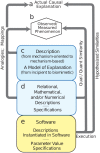Credibility, Replicability, and Reproducibility in Simulation for Biomedicine and Clinical Applications in Neuroscience
- PMID: 29713272
- PMCID: PMC5911506
- DOI: 10.3389/fninf.2018.00018
Credibility, Replicability, and Reproducibility in Simulation for Biomedicine and Clinical Applications in Neuroscience
Abstract
Modeling and simulation in computational neuroscience is currently a research enterprise to better understand neural systems. It is not yet directly applicable to the problems of patients with brain disease. To be used for clinical applications, there must not only be considerable progress in the field but also a concerted effort to use best practices in order to demonstrate model credibility to regulatory bodies, to clinics and hospitals, to doctors, and to patients. In doing this for neuroscience, we can learn lessons from long-standing practices in other areas of simulation (aircraft, computer chips), from software engineering, and from other biomedical disciplines. In this manuscript, we introduce some basic concepts that will be important in the development of credible clinical neuroscience models: reproducibility and replicability; verification and validation; model configuration; and procedures and processes for credible mechanistic multiscale modeling. We also discuss how garnering strong community involvement can promote model credibility. Finally, in addition to direct usage with patients, we note the potential for simulation usage in the area of Simulation-Based Medical Education, an area which to date has been primarily reliant on physical models (mannequins) and scenario-based simulations rather than on numerical simulations.
Keywords: Simulation-Based Medical Education; computational neuroscience; mechanistic modeling; model sharing; modeling and simulations; multiscale modeling; personalized and precision medicine; verification and validation.
Figures



References
-
- Ascoli G. A., Donohue D. E., Halavi M. (2007). NeuroMorpho.Org: a central resource for neuronal morphologies. J. Neurosci. 27 9247–9251. 10.1523/JNEUROSCI.2055-07.2007 - DOI - PMC - PubMed
-
- Bird R. B., Stewart W. E., Lightfoot E. N. (1960). Transport Phenomena, 1st Edn Hoboken, NJ: John Wiley & Sons, 808.
Publication types
Grants and funding
LinkOut - more resources
Full Text Sources
Other Literature Sources

